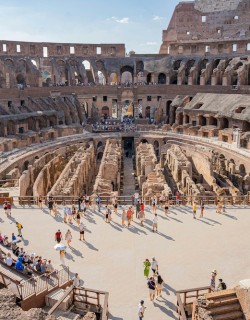In the middle of the Tiber, with Trastevere on one side and the Jewish Ghetto on the other, is a boat-shaped island. For most tourists, Tiber Island (Isola Tiberina) is only a convenient crossing point, rather than a destination in itself, but the island is worth exploring in-depth. As you’ll discover on our Hidden Beauty of Rome Tour, there’s more to Tiber Island than meets the eye.
The island was supposedly formed in the 6th century BC, after the fall of the tyrant Tarquinius Superbus. Tarquinius, who was the seventh king of Rome, has the dubious honour of being one of Rome’s most unpopular rulers of all time. After his death an angry mob threw his body into the river, where it settled on the riverbed, accumulating so much silt that it grew to form Tiber Island. An alternative legend says that Romans collected all the wheat belonging to their former ruler and threw it into the Tiber, where it eventually became the foundation of the island.
Many centuries ago, Tiber Island was considered a dangerous, lawless place, inhabited by criminals and people suffering from contagious diseases. But that all changed with the construction of a temple to Aesculapius, the Greek god of healing, in the 3rd century BC. Legend has it that the Roman Senate sent a delegation to Epidauros to find a statue of Aesculapius. The Romans took a snake from the temple of Epidauros and returned to Rome by boat. As they travelled up the Tiber, the snake slithered off the ship, and disappeared on Tiber Island. Interpreting this as a sign from the god, the people of Rome decided to build the temple on the island.
In reality, the island was probably chosen because of its isolation from the rest of Rome, protecting citizens from infectious diseases such as the plague. But the legend of the ship and the snake captured the popular imagination, to such an extent that Tiber Island was even re-modelled in the 1st century, in order to resemble a ship. The travertine outline of the island looks like a prow and stern, while the obelisk represents a mast. If you look closely, you can see a carving of the snake and Aesculapius’s rod on the “prow” of the island.
Even today, Tiber Island remains associated with healing, as the site of the 16th century hospital Fatebenefratelli, which takes up most of the island. There’s also a beautiful Baroque church with 10th century origins, San Bartolomeo all’Isola. The church contains a range of interesting relics, associated with saints and martyrs throughout the centuries, as well as frescoes by the Baroque painter Antonio Carracci. Overlooked by most tourists, San Bartolomeo is one of the most tranquil churches in the city centre.
Despite its central location, Tiber Island is a haven of peace and quiet. As you walk around the circumference of the island, close to the rushing waters of the Tiber, it’s hard to believe you’re in the very centre of a capital city. The island becomes even more atmospheric on summer evenings, when it hosts the annual Isola del Cinema film festival. A walking tour of Tiber Island, a traditional Roman dinner at Sora Lella, and a film by the riverside. What better way to spend a day in Rome?
~by Alexandra Turney~



